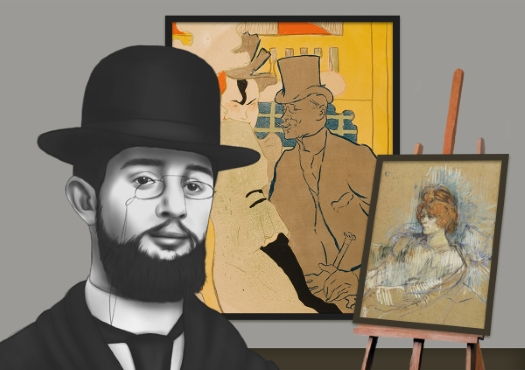Summary of Henri de Toulouse-Lautrec
In addition to being the artist who designed the Moulin Rouge's legendary posters, Toulouse-Lautrec was an aristocrat, dwarf, and party animal who invented a cocktail called the Earthquake (half absinthe, half cognac). His favorite pursuits were dressing up (geisha girl and clown get-ups were among his more memorable party outfits) and frequenting Parisian brothels, where he was a V.I.P. Like insects trapped in amber, his paintings, drawings and of course his famous posters preserve the swirl of energy, mix of classes and cultures, and the highs and lows of urban life in 19th-century Paris.
Accomplishments
- Toulouse-Lautrec was the first artist to elevate advertising to the status of a fine art. This is an extraordinary shift in the history of art, obliterating the boundaries between high (painting, drawing, sculpture) and low (posters, logos and other forms of visual culture) art. Acknowledging that some of his greatest masterpieces were posters for nightclubs does not in any way diminish their value. On the contrary, it set the gold standard for great commercial artists from Alphonse Mucha to Andy Warhol.
- In contrast to nearly all of the other artists in his circle, Toulouse-Lautrec had no trouble making a living. This is chiefly because Parisian business owners realized they could make money from his unique (modern) vision. In contrast to artists who worked for private collectors, galleries or the government, he worked for the entertainment business, where selling drinks and tickets was the bottom line. Jane Avril, one of his closest friends and one of Montmartre's most beloved cabaret dancers, later wrote: "It is more than certain that I owe him the fame that I enjoyed dating from his first poster of me."
- Thanks to his childhood tutor - also an art therapist - who encouraged him to shift his energy from riding to drawing (a safer pursuit for a child struggling with illness), Toulouse-Lautrec's early passion for physical activity was channeled directly into his art. The breathless excitement and athleticism of his sinuous line is like muscle memory - physical energy transposed into art.
- By sheer force of will, Toulouse-Lautrec turned his disability into a superpower. At a time when the only acceptable designation for persons with disabilities was freak, Toulouse-Lautrec used his unique appearance to his advantage. It allowed him to disappear into a crowd or the corners of a bedroom, seeing others without being seen.
- Toulouse-Lautrec's remarkable observations of people on the margins of society almost certainly stems from his status as an outsider. The crooners, dancers, acrobats, and prostitutes with whom he socialized were his adopted family. He identified with them, and there is every indication that he saw them as equals.
- More than simply a brilliant advertiser and artist, Toulouse-Lautrec was an important informal visual historian of urban life in Belle Époque Paris. The film "Moulin Rouge" and other period pieces based on the Belle Époque, are heavily informed by his posters, prints, and paintings.
The Life of Henri de Toulouse-Lautrec
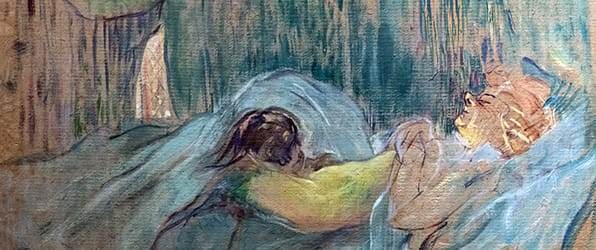
Toulouse-Lautrec may be best remembered as the master of Art Nouveau posters, but this curious individual stood at just 5’ high, was a party animal, a brother regular, an occasional cross-dresser, and a good friend to marginalized people of all sorts - from “circus freaks” to homosexuals to prostitutes.
Important Art by Henri de Toulouse-Lautrec
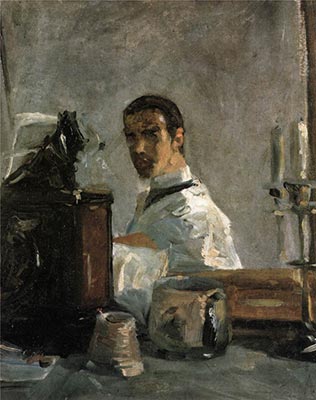
Self Portrait in Front of a Mirror
This is one of few self-portraits Toulouse-Lautrec painted, as he was incredibly self-conscious about his appearance, and the only one in which the artist is the sole focus. In it, he uses peinture a l'essence (oil paint, thinned with turpentine), applied directly onto cardboard to create a loose, sketchy effect. He would continue to use this technique throughout his career, adapting it to his sensibilities as a mature artist. Here the artist is both literally and figuratively emerging: the looseness of the brushwork makes it evident that he has studied Impressionism, but there is a darkness here, perhaps even a hint of the sinister, and a depth to the composition that departs from the buoyancy of the Impressionist palette and mood.
Oil on cardboard - Musée Toulouse-Toulouse-Lautrec, Albi
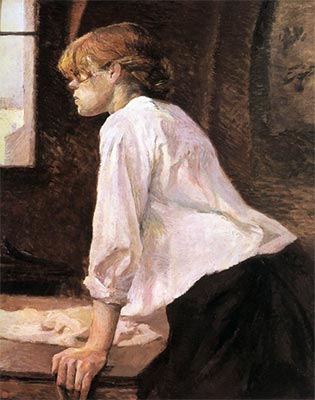
The Laundress
One of a series of portraits of Carmen Gaudin done by Toulouse-Lautrec during his Paris years, The Laundress is meant to expose the raw, somber and gritty world of the working-class. Toulouse-Lautrec poses the prostitute - one of his favorite models - as a laundress, taking a break from her physically intensive and exhausting work. And while Toulouse-Lautrec was famous for wanting to expose the hardship of Parisian life, there is a subtle delicacy and warmth to this work that belies his affection for this woman and her toils. This naturalism and painterly style is a cornerstone of Toulouse-Lautrec's earlier works, once again calling forth Degas' influence.
Oil on canvas - Private Collection
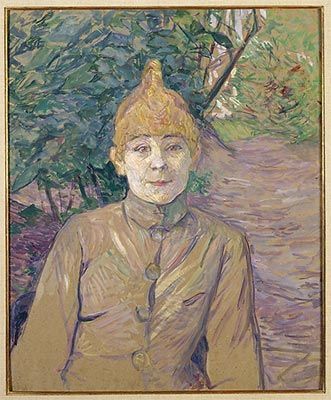
The Streetwalker (Le Casque d'Or)
While images of working-class people and prostitutes certainly existed before the 19th century, these subjects were almost invariably portrayed as types, not individuals. Though not alone in his quest to make portraits of working-class individuals (his friend Vincent Van Gogh was at this very moment working on a similar project in the South of France), Toulouse-Lautrec's approach to the subject is part of this revolutionary shift in art. At first glance, this is a rather conventional portrait of a woman seated in a garden. In brushy strokes, Toulouse-Lautrec describes the outdoor setting and long-sleeved button-down dress fastened high at the chin. Almost all of his concentration is focused on her distinctive features - the face, with its sharp features, whitened by rice powder, thin red lips, and red gold hair, piled high on top of her head. A slight smile plays at the corners of her eyes and mouth, as if the artist has just made a joke. The only visual hint at a departure from convention is the sitter's fully confrontational pose. She sits right at the edge of the frame, squares her shoulders, and looks out directly, a bit too close for polite comfort. What makes this portrait truly radical is, of course, its subject, a prostitute. Her street name was Le Casque d'Or (the Golden Helmet -a reference to her distinctive hair). Toulouse-Lautrec portrays this would-be scandalous subject, in a matter-of-fact, overall quite dignified manner --truly a radical departure from the norm.
Oil on cardboard - The Metropolitan Museum of Art, New York
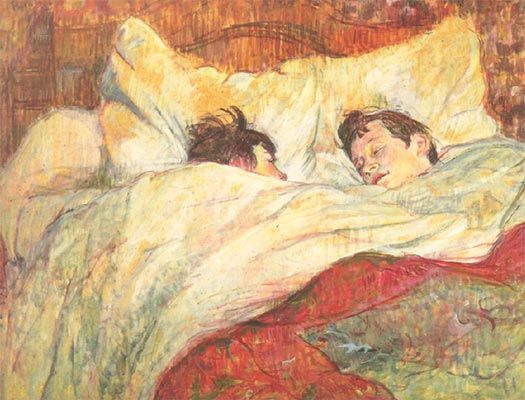
The Bed (Le Lit)
In this remarkable painting, two women lie gazing at one another, their cheeks flushed with the glow of intimacy. Toulouse-Lautrec frequented the houses of prostitution in Paris, and he admired the unguardedness of the women: "who stretch themselves out on the divans...entirely without pretensions." Some were lesbians who agreed to let him watch (for a fee, of course). Toulouse-Lautrec was by no means unique in being interested in girl-on-girl action. What was different was his interest in portraying it with subtlety and psychic depth, as opposed to lascivious spectacle, and an unprecedented degree of tenderness. Toulouse-Lautrec's enlightened position on homosexuality is well-documented. A staunch defender of gay rights, he stood by his friend Oscar Wilde throughout the writer's harrowing trial in Britain.
Oil and pastel on cardboard - Musée d'Orsay, Paris
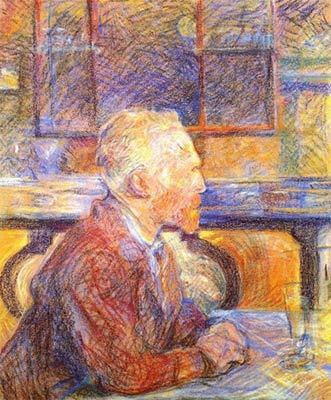
Portrait of Vincent Van Gogh
This painterly pastel, made well before Toulouse-Lautrec or his famous sitter were well-known, depicts Van Gogh seated pensively at a Montmartre café table. In front of him is a glass of absinthe, and he leans forward intently as if he has just spotted someone he knows. Toulouse-Lautrec and Van Gogh were friends, bonding over their passion for absinthe (also known as "the green fairy") which they viewed as a gateway to inspiration, and as both struggled with intense bouts of alcoholism. Paul Signac (another artist in their circle) remembered, "absinthes and brandies would follow each other in quick succession." Visible in this relatively early composition is Toulouse-Lautrec's command of color and line (evidence of his solid, traditional art school background). What makes Toulouse-Lautrec unique is also present here, he zeroes in on the visible traits (in this case, Van Gogh's sunken cheeks, heavy brow and anxious, forward-leaning pose) that capture the essence of a person.
Pastel on cardboard - The Van Gogh Museum, Amsterdam
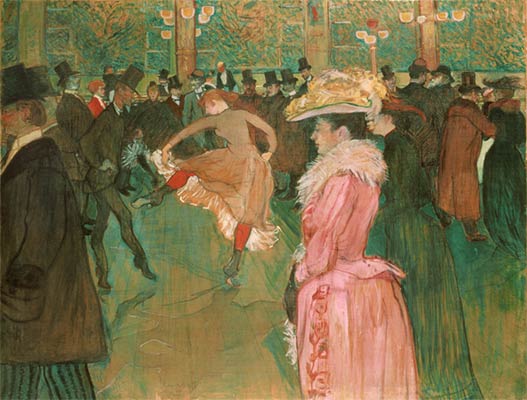
At the Moulin Rouge: The Dance
In this painting, Toulouse-Lautrec captures the exuberant energy and seedy underbelly of Paris nightlife. As if through an opening in the crowd, we glimpse the center of the Moulin-Rouge (a busy dance hall in the entertainment district of Montmartre). A dancer in mid-kick lifts her skirt above her knees (revealing much more leg than was considered ladylike), while a much more modestly dressed and apparently well-heeled woman with an upturned nose looks on, a hint of disapproval in her expression. Yet why is she in this space? What is she looking for? Toulouse-Lautrec, a great observer of nightlife, was familiar with Degas's depictions of the ballet. Here, he is giving a nod to the older artist, but has shifted the scene from the more regimented structure of the practice room (ballerinas were working-class in the 19th century, and many of them also worked as prostitutes) to the dance hall with its cast of characters: entertainers, dandies, and ladies of the night. The dynamic interaction between the pair of dancers at the center contrasts with the relative stasis in the rest of the crowd. The composition is like a spinning top with the female dancer at its center. Toulouse-Lautrec uses color to move the eye outward across the composition from right to left, from the pink dress to the red stockings, and over to a red blazer in the background, drawing us right into the action.
Oil on canvas - The Philadelphia Museum of Art
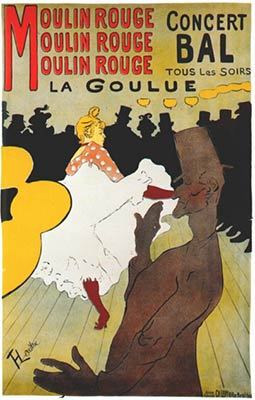
Moulin Rouge: La Goulue
Toulouse-Lautrec's greatest triumph was in lifting advertisement, previously seen merely as a commercial and thus inferior path for artists, to the status of an art form. This six-foot-tall poster for the Moulin Rouge, the famous dance hall in the center of Montmartre, is the artist's most recognizable advertisement, and it made him famous in his own lifetime. The naturalism of his earlier Impressionist style gave way to these large swaths of flat color with strong outlines and generalized silhouettes. Toulouse-Lautrec collected and studied Japanese Ukiyo-e prints. These sophisticated, high contrast compositions contained large swaths of flat color with strong outlines and generalized silhouettes that inform his lithographs. There is also an Art Nouveau aesthetic at play with the graphic nature and suggested (rather than delineated) curves.
Printed color lithograph - Indianapolis Museum of Art
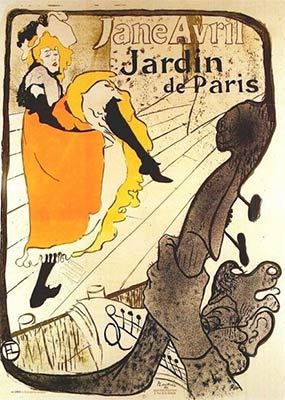
Avril
Jane Avril was one of the major starlets on the dance scene in 1880s Paris. This lithograph is an advertisement for Avril's major gig at the Jardin de Paris. Its aim was to generate excitement (and ticket sales) for an upcoming performance. On the left, Avril completes a high-kick, her eyes closed, transported by the passion of her own performance. On the right, a cello's neck, grasped by a man's hairy hand (and, yes, Toulouse-Lautrec fully intended the sexual innuendo here) rises from the orchestra pit, completing the border of the composition. In this daring work, Toulouse-Lautrec reveals his bawdy sense of humor, mastery of the medium, and true appreciation for Avril's mesmerizing talent.
Lithograph - The Metropolitan Museum of Art, New York City
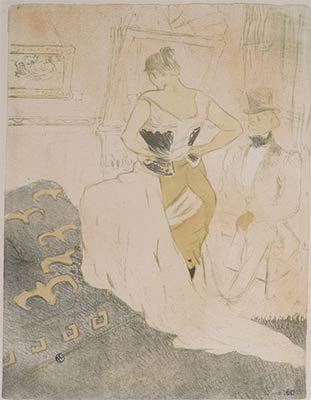
Femme en Corset
Prostitution was an overarching theme in Toulouse-Lautrec's work. Over the course of his career, Toulouse-Lautrec made over 50 paintings of prostitutes, none of which were exhibited during his lifetime. What he did publish was a series of 11 lithographs, entitled "Elles" (roughly translated "them" but in French, the designation is feminine). These works detail with unprecedented frankness the daily life and operations of a Paris brothel. A book of prints was more discreet than a painting, and could be put away when the owner wasn't looking at it. In this lithograph from the series, a prostitute stands in her underwear, unbuckling her corset while a well-dressed client who has paid for her services looks on, grasping his cane in one hand (it is unclear what the other hand is doing). As a paying client himself, Toulouse-Lautrec does not appear to have seen prostitution as a problem and displayed an unusual capacity for empathy for the vulnerability of the sex worker. He shows this in visual terms: with the exposed nape of her neck and the contrast between poses (sitting vs. standing, dressed vs. undressed, and watching vs. being watched) he emphasizes differences in social standing, and the fact that his pleasure is her work.
Lithograph - The Museum of Modern Art, New York
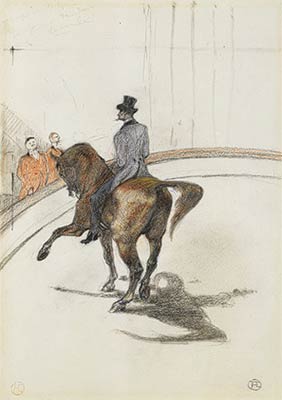
At the Circus: The Spanish Walk
Toulouse-Lautrec made this thoughtful and evocative drawing from memory at the end of his stay at a sanatorium in Paris. It was made for the express purpose of demonstrating his mental stability. He returns to a subject he had loved since childhood: horses. The circus, with its equestrian performers, held Toulouse-Lautrec's fascination throughout his mature career. This composition appears to have succeeded in convincing the doctors he had fully recovered his sanity. He was released.
Graphite, black and colored crayons, and charcoal - The Metropolitan Museum of Art
Biography of Henri de Toulouse-Lautrec
Childhood and Education
Henri Marie Raymond de Toulouse-Lautrec Monfa (the long name reflects his high-class social status) was born into an aristocratic family in the South of France. Raised in an atmosphere of privilege, he loved animals, and owned and rode horses. By age 8, it was clear that he suffered from a congenital illness that weakened his bones. After two serious riding accidents his legs stopped growing. At his full height, Toulouse-Lautrec was 5 feet tall, with the upper body of a man and the legs of a child. He walked with a cane and in considerable pain for the rest of his life.
Early Period
Unable to participate in the equestrian pursuits and other pleasures afforded other aristocrats of his age and station, Toulouse-Lautrec took art lessons with a local instructor, Rene Princeteau, who assisted him in channeling his passion for horses into drawing and painting. His first drawings were of horses, and the dynamism of line in Two Riders on Horseback (1879) shows his gift for observing and transposing action onto paper, cardboard or canvas. It was around that time that he discovered the Impressionists. Degas shared his love of horses and was his most important early influence, shown in Toulouse-Lautrec's elegant, gestural line, capture of movement, and immediate and early gravitation toward racy urban subjects.
Shunning the more prestigious traditional École des Beaux-Arts (which still taught students how to paint in the manner of the Italian Renaissance), upon his arrival in Paris in 1882 Toulouse-Lautrec sought (and could afford) individualized instruction in the small studios of Leon Bonnat and Bernard Corman. These teachers fostered unorthodox training and experimental approaches. Cormon's students included the renegades Vincent van Gogh and Emile Bernard, who became Toulouse-Lautrec's friends. Unchaperoned for the first time, the teenage Toulouse-Lautrec went wild in Paris, and its colorful nightlife became the center of his world. Despite ongoing struggles with his health, he was - by all accounts - the life of the party. Exceedingly charming, gracious, witty, and sarcastic, he became a fixture in Montmartre's cabarets, bars, circuses, and brothels, where he knew the prostitutes by name (they, in turn, affectionately called him "the Coffeepot" - an affectionate reference to the diminutive artist's generous proportions). Learning from a circle of friends and mentors in Paris that worked hard and played hard, he developed his unforgettable shorthand approach to observing from life. As he sat in the theater or circus, he sketched the performers. When in the brothel, he sketched the prostitutes. Like the Impressionists, he preferred to work on site, in front of the motif, beginning and completing his compositions on the spot. Unlike the Impressionists, (with the notable exception of Degas) who gravitated toward scenes of upper-middle-class leisure, Toulouse-Lautrec chose urban nightlife, the more disreputable the better.
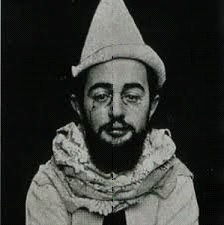
His diminutive stature allowed him a degree of invisibility, so that he could observe others closely. Prostitutes and performers, accustomed to being judged, were not afraid of him. His portrait of the prostitute known as La Casque d'Or in The Streetwalker (1890-91) captures the unprecedented frankness of his approach, and reflects the degree to which his models trusted him.
Perhaps because he had always felt like an outsider, Toulouse-Lautrec developed a circle of friends on the margins of society to whom he was exceedingly generous; they looked out for him, too. Dancers, crooners, and circus performers that lived and worked in the bohemian Montmartre neighborhood of Paris became his friends.
Mature Period
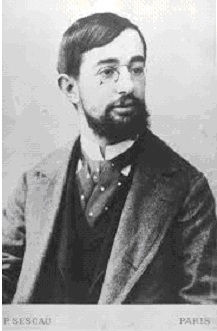
Commercial success came early to the talented young artist, who was literally an overnight sensation. Three thousand copies of Toulouse-Lautrec's very first poster for the Moulin Rouge were hung around the city one December evening and crowds came pouring into the cabaret, stimulated by this memorable image. As a token of appreciation for the artist's work (and to ensure that he would be available to do future work for them), the cabaret reserved seating for him, and displayed his paintings on their walls.
Toulouse-Lautrec's arrival in Paris coincided with an explosion of activity in the entertainment district of Montmartre and a leap in the sophistication of the advertising business. Stimulated by an influx of people moving from the countryside to Paris (working-class people who found employment in the city's circuses, bars and cafés, and the moneyed classes with resources), business owners and entertainers vied with one another for the business of customers who decided on the evening's entertainment based on the word on the street. Posters were intended to generate buzz for a fickle and distractible clientele who chose to attend an event based on whether or not they liked the poster. Toulouse-Lautrec had everything it took to generate interest in these venues: colorful, eye-catching, dynamic forms that captured the essential characteristics of the venue and its performers. Future venues hung his advertising posters by the thousands, and they became collector's items during his lifetime. The anarchist critic Felix Fenéon published an article with explicit instructions on how to take one of Toulouse-Lautrec's posters down before the glue had a chance to dry.
Later Period
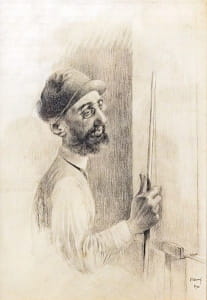
Once business owners knew how good he was, Toulouse-Lautrec, who wasn't exactly hard up for money to begin with, had an unlimited supply of work. He essentially had the ideal job: he could pick and choose what performances he wanted to go to, usually admission-free. He continued generating posters for the Moulin Rouge, and was a VIP at virtually any other performance in Paris that struck his fancy: circus acts, the Jardin de Paris and other nightclubs. He was also a regular at the city's brothels where he availed himself of the services of the prostitutes, who treated their customer with a level of kindness and humanity to which he was unaccustomed. He reciprocated with financial generosity and a series, (Elles) that affords a level of human insight into the business of prostitution that is unavailable in any other study from the period. He moved into these establishments for short periods of time, raising eyebrows among those in the know when the artist gave out his address. An occasional prostitute who modeled for and also took art lessons with Toulouse-Lautrec was Suzanne Valadon, who moved on to a significant career as a visual artist.
Toulouse-Lautrec died in 1901, a few weeks shy of his 37th birthday. The cause was probably alcoholism and syphilis. While he suffered terribly, Toulouse-Lautrec wasn't one to feel sorry for himself, and neither should we. Part of the deep pleasure of looking at his work is the manner in which it acknowledges the value of our time. Like a passerby on the street, even if we have only a second to look, we get something out of it. In his brilliant, graphic line that never stops moving, what comes through is his zest for life.
The Legacy of Henri de Toulouse-Lautrec
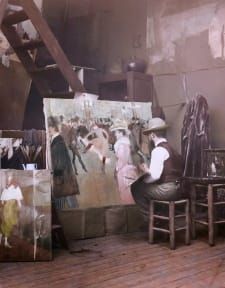
Toulouse-Lautrec's career coincided with the expansion of the urban middle class - people with money to spend on entertainment, but who weren't part of high society. He anticipated and shaped the needs of this audience and his style began to make an impact during his lifetime, inspiring the exaggerated outlines, languid, organic forms and script writing that appeared in the Art Nouveau movement.
He is one of the pillars holding up the rest of modern art. Without him, you'd have no Picasso, Warhol, Diane Arbus, or Chuck Close. Toulouse-Lautrec's celebration of consumer culture and iconic popular advertisements paved the way for Pop art. In addition his portrayals fueled the obsession with superstars that persists today (think Nicki Minaj, Justin Bieber, Madonna, Miley Cyrus - the list goes on and on).
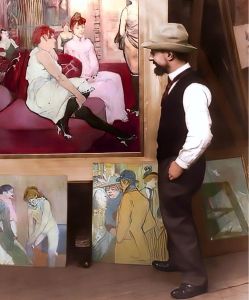
One further aspect of Toulouse-Lautrec's achievement deserves special attention. Despite the celebrated freedom and individualism of modern art, few artists of any period have been able to overcome social prejudice. While rubbing elbows with the riffraff was an acceptable, even encouraged, rite-of-passage among avant-garde artists, Degas, Manet, and Van Gogh maintained a certain aloofness from their working-class subjects. Toulouse-Lautrec was able to develop true friendships that transcended the rigid class structure of 19th-century Paris. His brilliant insights into the glitter and desperation of Paris nightlife, a study in contrasts, were not only more brilliant but more humane than any that had come before him, setting the bar high for future artists.
Influences and Connections

Useful Resources on Henri de Toulouse-Lautrec
- Toulouse-Lautrec: A LifeBy Julia Frey
- Toulouse-Lautrec and MontmartreBy Richard Thomson, Phillip Dennis Cate and Mary Weaver Chapin
- Toulouse-Lautrec and La Vie Moderne: Paris 1880-1910Our PickBy Phillip Dennis Cate and Belinda Thomson
- Toulouse-Lautrec Illustrates the Belle ÉpoqueOur PickBy Hilliard T. Goldfarb
- Toulouse-Lautrec and the Stars of ParisOur PickBy Helen Burnham
- Toulouse-Lautrec: The Moulin Rouge and the City of LightOur PickBy Robert Burleigh
- Explosive Acts: Toulouse-Lautrec, Oscar Wilde, Felix Feneon, and the Art & Anarchy of the Fin de SiecleBy David Sweetman
- 360 Color Paintings of Henri de Toulouse LautrecOur PickBy Jacek Michalak
- The Paris of Toulouse-Lautrec: Prints and Posters From The Museum of Modern ArtOur PickBy Sarah Suzuki
- Toulouse-Lautrec (Basic Art Series 2.0)Our PickBy Matthias Arnold
- Toulouse-LautrecBy Hajo Duechting
- Toulouse-Lautrec and Jane Avril: Beyond the Moulin RougeBy Anna Greutzner Robins and Nancy Ireson
- Degas, Sickert and Toulouse-Lautrec: London and Paris 1870-1910By Anna Gruetzner Robins and Richard Thomson
- The Dancer: Degas, Forain, Toulouse-LautrecBy Annette Dixon
 Ask The Art Story AI
Ask The Art Story AI